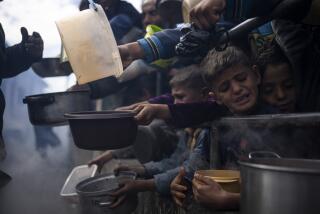Shift Seen in Palestinian Unrest Tactics
- Share via
JERUSALEM — The nature of the Palestinian rebellion against the Israeli occupation of the West Bank and Gaza Strip appeared Wednesday to be changing, with the lynching of a suspected collaborator with the Israelis and an attack with automatic weapons on Israeli forces.
According to army and Palestinian sources, a West Bank Arab thought to be an Israeli collaborator was strangled and then hanged Wednesday by a Palestinian mob in the village of Qabatiya after he shot and killed a 4-year-old boy during an attack on his house.
The deaths brought to at least 63 the number of Palestinians killed since the uprising began Dec. 9.
There have been numerous attacks on suspected collaborators and informers. There are said to be thousands of these people in the occupied territories. But Wednesday’s incident, which came after leaflets were distributed calling for strong action against informers, was the first known killing of a suspected collaborator. It raised the possibility of communal violence among the Palestinians.
The lynching in Qabatiya came after a mob marched on the house of Mohammed al Ayed, an employee of the Israeli civil administration who was described by Mayor Zaharan Hassouna as “well known for working with the Israelis.”
Ayed reportedly went to the roof of his house and opened fire on the crowd with an Israeli-made Uzi submachine gun, killing a 4-year-old boy. The sources said 13 other people were wounded.
The demonstrators again attacked the house. They seized Ayed, dragged him into the street and, according to military sources, choked him to death with a length of electrical cord, then hanged his body from a power pole.
Another sign of the changing nature of the uprising, as well as an escalation of the violence, was the ambush Tuesday night in the Gaza Strip of an Israeli security patrol by attackers using explosives and automatic weapons.
According to military sources, a car carrying agents of Shin Bet, the Israeli security force, was forced to stop when explosives were touched off on a narrow dirt road leading south from Gaza City toward Jewish settlements. The agents were then attacked by automatic rifle fire, the sources said, but were uninjured and shot back. The attackers fled, apparently unharmed.
This was the first reported use of firearms by Palestinians against any Israeli--military, security or civilian--since the uprising began. It raises several possibilities that are regarded as frightening by both sides.
Until now, the protesters have used stones, gasoline bombs and, infrequently, knives in their clashes with Israelis. Although the army says more than 200 soldiers have been hurt, none have been killed, and most of the injuries have been minor. Defense Minister Yitzhak Rabin said earlier this week that not one bullet had been fired at an Israeli.
The lack of the use of firearms has been a puzzling aspect of the uprising, although Palestine Liberation Organization officials say they have ordered the protesters not to shoot at the Israelis, apparently to avoid a shift in world opinion, which is now thought to be behind the Palestinians.
Sources close to those believed to be the leaders of the protest movement, the United National Leadership For the Uprising in the Occupied Territories, said as late as Tuesday that they oppose using firearms.
Warning From Officials
Israeli military authorities from Rabin on down have warned that armed action by the protesters will bring severe reaction from the army, which is already operating under a policy of using deadly force to protect soldiers’ lives.
If the Gaza attack was made despite the wishes of leaders of the PLO and the uprising, it increases the probability that the more radical and impatient local committees that actually run the street operations against the Israelis are challenging the strategy, if not the very leadership, of the Palestinian movement.
There are already strong currents of dissent within the uprising, which many experts say began as a purely spontaneous outbreak and only recently has come under the control, more or less, of the PLO.
This dissent reportedly forced PLO Chairman Yasser Arafat to back away from authorizing a meeting by Palestinian representatives with Secretary of State George P. Shultz while he is in Israel for talks on a Middle East peace agreement. Shultz is due to arrive today.
Also, there are reports that the more radical elements are responsible for this week’s call for more violent demonstrations, a more stringent application of commercial strikes, and the prevention of Arab workers going to jobs in Israel proper.
Wednesday was designated by the uprising leaders as the first day of a two-day general strike, including major demonstrations, a total shutdown of stores and transportation and a strike by Arab workers who hold jobs in Israel proper to protest the Shultz visit.
The commercial aspects of the strike were effective, but snow, sleet and rain kept demonstrations in the West Bank to a generally low level.
More to Read
Sign up for Essential California
The most important California stories and recommendations in your inbox every morning.
You may occasionally receive promotional content from the Los Angeles Times.










